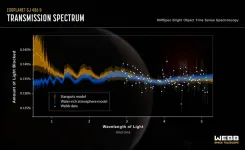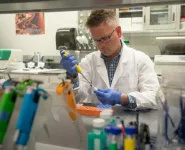(Press-News.org) For people with cancer, chemotherapy saves lives, but for some patients, the treatment comes with a side effect—heart damage. Screening cancer drugs for cardiotoxicity has been an ongoing challenge as heart cells don’t naturally grow in a dish, requiring researchers to do this critical testing using cardiac tissue from rodent models. A new study from researchers at Cummings School of Veterinary Medicine at Tufts University and Tufts Medical Center reports that heart tissue obtained through organ donations from dogs dying of other causes are a promising platform for testing cancer drug toxicity, offering scientists a new alternative.
The organ donation program at Cummings School of Veterinary Medicine works the same as organ donation programs in people, with owners agreeing to donate the heart from their pet when they die of other causes in order to support research in animal and human health. The work published recently in the journal PLOS ONE.
“Though cancer drugs in the human market can be a powerful tool in treating the disease, what is not often considered are the long-term cardiovascular toxicity effects because it takes years before you realize the heart is not functioning as well,” says senior author Vicky Yang, a cardiologist and associate professor at Cummings School of Veterinary Medicine. “With our cell culture platform, you can very quickly recreate cancer drugs’ secondary effects and manipulate the biological causes to make the treatments less toxic.”
As a proof-of-concept, the research team exposed canine heart slices to doxorubicin, a chemotherapy drug used in humans and dogs to suppress a range of solid tumors but is also known to cause life-threatening heart problems. Yang and colleagues observed that the heart cells were not recovering from the injury caused by the drug, a process called autophagy, validating findings from rodent studies.
Unexpectedly, the canine heart slices stayed alive for over a week, lasting more than twice as long as heart cells taken from rodent models and at less cost. Due to dogs’ genetic similarity to humans, the platform yields quicker, more comprehensive, and more clinically relevant drug screens than standard mouse models. “We still don’t know why our platform works so well, but maybe we aren’t giving heart tissue enough credit,” Yang says. “Maybe heart tissue is more resilient than we think.”
Testing cancer drugs for side effects requires costly, labor-intensive research in rodent models. Dogs have more genes in common with humans and can experience the same cardiac side effects as human patients when on chemotherapy. So, the canine heart slice screens can provide quicker, more comprehensive, clinically relevant data than rodent models.
It took over two years of trial and error before Yang and colleagues finalized their platform. The project was a collaboration between Cummings School and Tufts Medical Center, bringing together human cardiologists and oncologists, as well as veterinary specialists and basic scientists working with rodent models. Their shared goal was to piece together the best way to take cardiotoxicity data from the lab and apply it to human patients.
Yang acknowledges that a limitation to scaling this platform is access to an academic veterinary hospital, such as Henry and Lois Foster Hospital for Small Animals, which has an organ donation program that provides the researchers with heart tissue. Translational cardio-oncology is an emerging field, and the researchers are eager to collaborate with other clinicians to test a wider range of cancer drugs.
Howard H. Chen from the Molecular Cardiology Research Institute at Tufts Medical Center is co-senior author of the paper.
Research reported in this article was supported by the National Institutes of Health under awards K01OD028205-01, K99/R00HL121152, K08HL146959, and 1R01CA243542-01. Complete information on authors, funders, and conflicts of interest is available in the published paper. The content is solely the responsibility of the authors and does not necessarily represent the official views of the funders.
END
A new method to test cancer drug toxicity
Researchers from Cummings School of Veterinary Medicine and Tufts Medical Center have developed a new platform to test cardiac side effects of chemotherapy
2023-05-01
ELSE PRESS RELEASES FROM THIS DATE:
Webb finds water vapor, but from a rocky planet or its star?
2023-05-01
The most common stars in the universe are red dwarf stars, which means that rocky exoplanets are most likely to be found orbiting such a star. Red dwarf stars are cool, so a planet has to hug it in a tight orbit to stay warm enough to potentially host liquid water (meaning it lies in the habitable zone). Such stars are also active, particularly when they are young, releasing ultraviolet and X-ray radiation that could destroy planetary atmospheres. As a result, one important open question in astronomy is whether a rocky planet could maintain, or reestablish, an atmosphere in such a harsh environment.
To help answer that question, astronomers ...
Cannabis knocks down pain, improves sleep and lifts brain fog in cancer patients
2023-05-01
Cancer patients who use cannabis to address their symptoms have less pain and sleep better, according to new University of Colorado Boulder research. But they also experience another, unexpected, benefit: After a few weeks of sustained use, they seem to think more clearly.
“When you’re in a lot of pain, it’s hard to think,” said senior author Angela Bryan, a professor of psychology and neuroscience at CU Boulder and a cancer survivor. “We found that when patients’ pain levels came down after using cannabis for a while, their cognition got better.”
The small but groundbreaking study, published ...
Jutras Lab awarded $1.2 million to create rapid and accurate Lyme disease testing
2023-05-01
A rapid, at-home test that can diagnose acute Lyme disease? That is the goal for researcher Brandon Jutras and his team at Virginia Tech’s Fralin Life Sciences Institute.
Through the support of a recent $1.2 million multiyear therapeutic/diagnostic research tick-borne disease grant awarded by the Department of Defense, Jutras' vision may one day become a reality. This research award aims to improve patient care and quality of life for military service members, veterans, and their beneficiaries as well as the American public living with Lyme disease and other tick-borne diseases.
“Current ...
Study: Police murder of George Floyd associated with short-term spike in firearm assaults on US police officers
2023-05-01
The police murder of George Floyd sparked nationwide protests in the summer of 2020 and revived claims that public outcry over such high-profile police killings perpetuates a violent “war on cops.” In a new study, researchers assessed if and how patterns of firearm assault on police officers in the United States were influenced by the police murder of Floyd. The study found that Floyd’s murder was associated with a three-week spike in firearm assaults on police, after which the trend in such assaults dropped to levels slightly above those predicted by pre-Floyd ...
West Antarctic Ice Sheet retreated far inland, re-advanced since last Ice Age
2023-05-01
WASHINGTON — The West Antarctic Ice Sheet is melting rapidly, raising concerns it could cross a tipping point of irreversible retreat in the next few decades if global temperatures rise 1.5 to 2.0 degrees Celsius (2.7 to 3.8 degrees Fahrenheit) above preindustrial levels. New research finds that 6,000 years ago, the grounded edge of the ice sheet may have been as far as 250 kilometers (160 miles) inland from its current location, suggesting the ice retreated deep into the continent after the end of the last ice age and re-advanced before modern retreat began.
“In the last few thousand years before we started watching, ...
Young women more likely to return to the hospital in year following heart attack
2023-05-01
Young women who experience a heart attack have more adverse outcomes and are more likely to end up back in the hospital compared to men of a similar age in the year following discharge. According to a study published in the Journal of the American College of Cardiology, second heart attack and chest pain due to the heart are the most common causes of rehospitalization, but non-cardiac hospitalizations showed the most significant disparity.
“This all begins with public awareness towards preventing heart attacks and screening ...
Risk of rehospitalization in younger women after heart attack nearly double that of men
2023-05-01
Women aged 55 years and younger have nearly double the risk of rehospitalization in the year immediately after a heart attack compared to men of similar age, according to a study supported by the National Institutes of Health. Higher rates of risk factors such as obesity, heart failure, and depression among women most likely contributed to the disparity.
The findings suggest a need for closer health monitoring of the approximately 40,000 American women aged 18 to 55 years who have heart attacks each year following hospital discharge, and a better understanding of the reasons behind ...
Nuances of the forest-water connection
2023-05-01
The infrastructure that brings drinking water to homes is an investment. For millions of people, forests are part of the system behind their faucets. Over the coming decades, many forested watersheds could be lost to development, lowering water quality and raising water treatment costs, according to a new study published in the journal Science of the Total Environment.
The research team focused on the forest-water connection in the southern U.S., a complex, heterogeneous region and, unfortunately, an ideal place for studying forest loss and worsening water quality. ...
Study identifies genetic mutations that contribute to adult epilepsy
2023-05-01
Epilepsy affects approximately 1-in-26 people and the most common form, known as temporal lobe epilepsy (TLE), often cannot be adequately treated with anti-seizure medications. Patients with this form of epilepsy may require neurosurgery to provide relief from seizures. The condition’s origins and progression are not well understood, and it has been unclear if genetic mutations may contribute to TLE. A new study by investigators from Mass General Brigham, in collaboration with colleagues at Boston Children’s Hospital, sheds new light on the role of somatic mutations in TLE — DNA alterations that occur after conception — and suggests the potential ...
Massive radio array to search for extraterrestrial signals from other civilizations
2023-05-01
May 1, 2023, Mountain View, CA – One of the world’s most powerful radio telescope arrays is joining the hunt for signals from other galactic civilizations. The National Science Foundation’s Karl G. Jansky Very Large Array (VLA), situated about 50 miles west of Socorro, New Mexico, is collecting data that scientists will analyze for the type of emissions that only artificial transmitters make, signals that would betray the existence of a technically accomplished society.
“The VLA is the ...
LAST 30 PRESS RELEASES:
Survey reveals ethical gaps slowing AI adoption in pediatric surgery
Stimulant ADHD medications work differently than thought
AI overestimates how smart people are, according to HSE economists
HSE researchers create genome-wide map of quadruplexes
Scientists boost cell "powerhouses" to burn more calories
Automatic label checking: The missing step in making reliable medical AI
Low daily alcohol intake linked to 50% heightened mouth cancer risk in India
American Meteorological Society announces Rick Spinrad as 2026 President-Elect
Biomass-based carbon capture spotlighted in newly released global climate webinar recording
Illuminating invisible nano pollutants: advanced bioimaging tracks the full journey of emerging nanoscale contaminants in living systems
How does age affect recovery from spinal cord injury?
Novel AI tool offers prognosis for patients with head and neck cancer
Fathers’ microplastic exposure tied to their children’s metabolic problems
Research validates laboratory model for studying high-grade serous ovarian cancer
SIR 2026 delivers transformative breakthroughs in minimally invasive medicine to improve patient care
Stem Cell Reports most downloaded papers of 2025 highlight the breadth and impact of stem cell research
Oxford-led study estimates NHS spends around 3% of its primary and secondary care budget on the health impacts of heat and cold in England
A researcher’s long quest leads to a smart composite breakthrough
Urban wild bees act as “microbial sensors” of city health.
New study finds where you live affects recovery after a hip fracture
Forecasting the impact of fully automated vehicle adoption on US road traffic injuries
Alcohol-related hospitalizations from 2016 to 2022
Semaglutide and hospitalizations in patients with obesity and established cardiovascular disease
Researchers ‘listen in’ to embryo-mother interactions during implantation using a culture system replicating the womb lining
How changing your diet could help save the world
How to make AI truly scalable and reliable for real-time traffic assignment?
Beyond fragmented markets: A new framework for efficient and stable ride-pooling
Can shape priors make road perception more reliable for autonomous driving?
AI tracks nearly 100 years of aging research, revealing key trends and gaps
Innovative techniques enable Italy’s first imaging of individual trapped atoms
[Press-News.org] A new method to test cancer drug toxicityResearchers from Cummings School of Veterinary Medicine and Tufts Medical Center have developed a new platform to test cardiac side effects of chemotherapy




